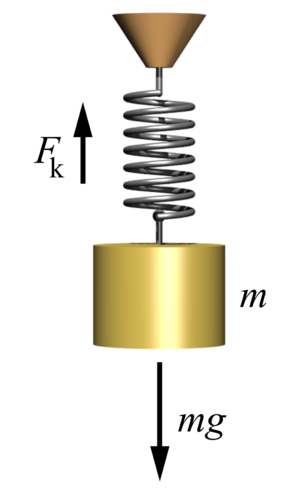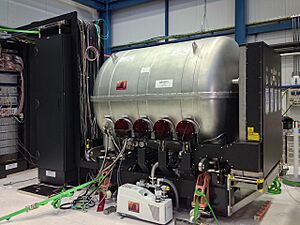Force facts for kids
In science, a force is like a push or a pull between two things. It's called an interaction because if one thing pushes or pulls another, the second thing pushes or pulls back. This is part of Newton's third law. It means every action has an equal and opposite reaction.
Different forces work between different kinds of objects. For example, gravity pulls objects with mass together. Think of the sun and the earth. Another force is electromagnetic force. It acts between things with an electric charge, like an electron and the center of an atom. Gravity and electromagnetic force are two common examples.
A force can change how an object moves or its shape. For instance, a force can push or pull an object in a certain direction. This changes its momentum, which is how much "oomph" it has. Forces can make objects speed up, change direction, or change shape. The strength of a force is measured in units called Newtons (N). There are four main fundamental forces in physics.
A force is always a push, a pull, or a twist. It affects objects by moving them, changing their motion, or altering their shape.
Contents
Understanding Force: Newton's Second Law
According to Newton's Second Law of Motion, we can find the amount of force using a simple formula:
In this formula:
 stands for the force.
stands for the force. stands for the mass of an object. Mass is how much "stuff" an object has.
stands for the mass of an object. Mass is how much "stuff" an object has. stands for the acceleration of the object. Acceleration is how quickly its speed changes.
stands for the acceleration of the object. Acceleration is how quickly its speed changes.
This formula tells us that if a force acts on an object, it will make the object speed up. If the force is small and the object is heavy, it will take a long time to speed up a lot. But if the force is strong and the object is light, it will speed up very quickly.
Weight: Gravity's Pull
Gravity is a type of acceleration. Everything that has mass is pulled towards the Earth because of gravity. This pull is a force we call weight.
We can use Newton's Second Law to find weight. We just change  (acceleration) to
(acceleration) to  , which is the acceleration due to gravity on Earth.
, which is the acceleration due to gravity on Earth.
In this formula:
 stands for the weight of an object.
stands for the weight of an object. is the mass of the object.
is the mass of the object. is the acceleration due to gravity at sea level on Earth. It's about
is the acceleration due to gravity at sea level on Earth. It's about  .
.
This formula helps you calculate how much force gravity puts on an object if you know its mass. Remember, this specific  value is for Earth. If you were on the Moon or another planet,
value is for Earth. If you were on the Moon or another planet,  would be different.
would be different.
Force is a vector. This means it has both a strength (how strong it is) and a direction. Gravity always pulls objects downwards, towards the center of the Earth (unless you're in space!).
Gravitational Force: How Planets Move
There's another important equation for gravity, called the Law of Universal Gravitation. It helps us understand how gravity works between any two objects in the universe:
Let's break down what these letters mean:
 is the force of gravity between the two objects.
is the force of gravity between the two objects. is the gravitational constant. It's a special number that helps show how gravity accelerates objects.
is the gravitational constant. It's a special number that helps show how gravity accelerates objects. is the mass of the first object.
is the mass of the first object. is the mass of the second object.
is the mass of the second object. is the distance between the centers of the two objects.
is the distance between the centers of the two objects.
This equation is used to figure out how the Earth moves around the Sun, or how the Moon moves around the Earth. It also helps scientists understand how other planets, stars, and objects in space move.
The equation shows that if two objects are very heavy (have a lot of mass), there will be a strong gravitational force between them. But if they are very far apart, the force becomes much weaker.
Images for kids
-
Aristotle described force as anything that causes an object to move in an "unnatural" way.
-
Galileo Galilei helped us understand forces better by showing problems with Aristotle's ideas.
-
Relationship between force (F), torque (τ), and momentum vectors (p and L) in a rotating system.
See also
 In Spanish: Fuerza para niños
In Spanish: Fuerza para niños










